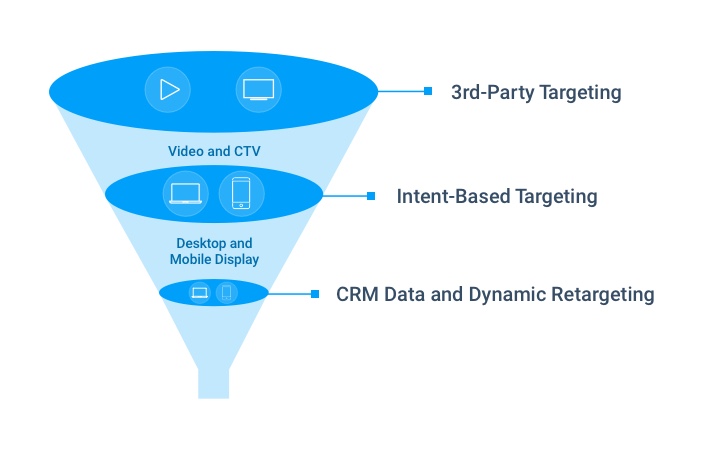It’s no secret that connected TV (CTV) has taken the digital advertising world by storm, and it’s not slowing anytime soon. In 2023, 88% of US households owned at least one internet-connected TV device, while the number of CTV users amounted to more than 110 million among Gen Z and Millennials.
CTV consists of any type of TV that can be connected to the internet and can stream digital video at a viewer’s convenience. CTV is a subset of over-the-top (OTT), which includes apps and services that don’t require subscriptions to traditional cable or pay-TV services. With more and more viewers rapidly switching from linear TV to streaming alternatives, it’s time for digital marketers to embrace the potential of this channel.
With CTV, you are able to show a video ad to a targeted audience group, through a television screen. The ability to show your uniquely targeted video ad on a bigger screen, in a familiar environment, to a captive audience is an ultimate win. And, you can easily supplement your video strategy with CTV by simply using your existing video assets.
So, who wouldn’t want to integrate CTV in their media mix? If you still need some convincing—here are 5 reasons why you need to leverage CTV advertising.
5 Reasons to Add CTV Advertising to Your Media Mix
1. CTV Offers Enhanced Targeting Capabilities
CTV ads are sold as impressions, the same way regular video ads or display ads would be sold through a programmatic platform. This means that you can apply the same targeting parameters that are available for those channels, for CTV.
For example, you could employ:
- 1st-party audiences including homepage visitors and past purchasers, on the big screen.
- 3rd-party segments to target households based on traits like age, gender, income, presence of kids or shopping intent.
- Lookalike audiences to target households that look most like your valuable 1st-party users by running a lookalike model on the platform.
Ad spots are purchased when a viewer matches your desired audience, and creative messaging then appears in full-screen, highly-viewable environments. The ability to target on CTV provides better audience efficiency and reduces media waste, and reduces the noise of reaching irrelevant viewers and households.
2. CTV Campaigns Can Be Leveraged For Retargeting
Beyond targeting audiences for your prospecting campaigns, CTV offers immense opportunity for highly-relevant retargeting campaigns.
Since CTV ads work with streaming data, users can be tracked across platforms. If a potential customer sees your ad on their smart TV, you can now track them across other devices and retarget them. This gives you the potential to boost your customer conversion rates and create a well-rounded cross-device approach that will provide a full story to the viewer experience.
3. CTV Offers Optimization and Measurement
With traditional TV ads, you would need to wait weeks or even months to receive performance reports to know exactly how the campaign performed. With CTV, you can track the impact of your campaigns in the same manner as with your other programmatic buys.
CTV metrics include impressions delivered, CPCV, VCR, view-through conversions, and unique device breakdown. You receive these metrics in real-time, which means you have the ability to view stats and make adjustments on the fly.
You can measure campaign results related to website visits or online purchases, and also offline behaviour. The ability to track the impact of your CTV campaigns with digital metrics, including video completion rates, as well as offline impact like increase of footfall traffic or in-store sales, is a great benefit of running on CTV.
4. CTV Enables Holistic Campaigns
Although CTV is a very effective tactic to use on its own, for an extensive campaign strategy, you will want to integrate CTV into your broader media mix. Combining your existing channels with the benefits of CTV will help you to get the best campaign results by allowing you to capture your engaged audience wherever they are online.
As much as we like to think that television viewers are glued to the screen, the reality is that many are actually browsing their phones or surfing the web simultaneously–and there’s research that backs this up.
Second screen usage behaviour is why a holistic campaign approach is so integral. It enables you to capture viewers who may be checking other devices while watching their CTV programming.
You’re able to seamlessly provide the same or similar content across these different devices and increase the chances that the viewer sees your ad and takes action. By engaging with the ad on a second screen, viewers can deepen their connection to the brand and increase the likelihood of conversion.
5. Opportunities For Brand Enhancement
There’s a reason why the television ads that air during the Super Bowl are so expensive. People remember them! If you have the budget to put toward one of these coveted ad spots, and you manage to secure one, you will definitely enhance your brand presence.
CTV provides a similar opportunity for brand enhancement, but year-round. With the video format, you’re able to tell compelling and engaging stories through a highly entertaining and memorable ad experience. Because video is so immersive, it creates strong brand recall, which is a valuable advantage for advertisers.
With video, you can also convey a lot of information in a short time, which means you have more opportunity to tell a story about your brand, and educate your audience about your offering.
How to Add a CTV Strategy to Your Existing Digital Buys
You now know 5 key reasons why you should integrate CTV into your media mix. But, how do you get started? Here’s an example of one way that an e-commerce retail brand could add CTV to their existing strategy.
Scenario
As an e-commerce brand with a deep product selection, you are looking to drive online purchases. The focus has been lower-funnel strategies, but now you are ready to try a high-impact channel to find quality prospects.
Strategy
Start with 3rd-party targeting based on your demographic for the top of the funnel. Then incorporate intent-based targeting based on purchase intent through a user’s online actions. Use your CRM data and dynamic retargeting at the bottom of the funnel. Specifically, retarget the viewers of your CTV ad across their other devices to drive them further down the funnel.

Use video, and specifically CTV, to raise awareness for your brand and leverage desktop and mobile display to drive the final purchases. As you retarget CTV viewers with other channels, you can drive efficient purchases by optimizing the lower-funnel channels to CPA.
The Benefit
A well-thought-out campaign that appropriately integrates connected TV into your media mix will put you at the head of the video advertising game, allowing you to tap into all effective advertising channels.
Not only that, but with a holistic, multi-channel strategy, you can analyze the results of your campaign across the different channels to optimize the campaign and reallocate budget as needed. Connected TV is not a replacement for your linear TV ads, nor is it meant to take over all your video budget. It really should be a complement to your entire digital strategy.
Start Integrating CTV Advertising
There are a few misconceptions about CTV that may be holding advertisers back from integrating this channel into their media mix. These concerns can be overcome through education as well as test-and-learn opportunities.
Putting in the effort to address concerns is worth it because the value of CTV will continue to grow. According to eMarketer, households with a connected TV device will climb to 87% by 2025.
Ready to run exceptional connected TV campaigns? Request a demo to learn more about StackAdapt.





